Humans-Homo sapiens-have lived in South America for at least 15,000 years and possibly longer. The earliest period of human occupation is generally called the Lithic Stage by archaeologists. During this time period the first post-glacial hunting and gathering groups lived in South America. The people were living in small groups which subsisted on hunting, fishing, and the gathering of wild plants.
At the southern end of South America is Patagonia. Today this is a region of steppe-like plains with a succession of 13 abrupt terraces which rise up to 100 meters (330 feet) at a time. The region’s current name comes from pagagón which was used by the Spanish explorer Magellan to describe the native giants that he encountered. The Native American inhabitants, the Tehuelches, had an average height of 5’11” as compared with 5’1″ for the Spaniards.
During the late Pleistocene era 15,000 years ago, the glaciers were beginning to recede. This was still an environment of glaciers, woods, and turquoise lakes. The weather at this time was becoming warmer and drier. Shrubs were beginning to replace the grasses which had supported a variety of animals. While this was a hostile environment, it was still occupied by humans.
Many of the mammals which inhabited Patagonia at the end of the Pleistocene have become extinct. At the site of Cueva Túnel, occupied by 11,500 BCE, archaeologists have found the remains of extinct animals, including Panthera onca (a jaguar) and Hippidion saldiasi (a small horse). At another site, Casa del Minero, archaeologists have found an extinct fox (Dusycion avus) and two distant relatives of today’s guanaco (Hemiauchenia paradoxa and Lama gracilis). The evidence from these sites shows that humans were hunting these extinct species at this time. The bones from some of these animals had been made into tools, including awls to perforate hides.
Most of the tools used by these early Native American residents of Patagonia were made from stone. The landscape had been formed by volcanic activity and this provided stone that was ideal for making tools. Outcrops of good rocks became quarries in which the extracted stones were knapped in situ into blanks from which tools would later be made.
In other parts of the Americas, Indian people would re-sharpen their stones as they got dull. In Patagonia, however, with the abundance of good stone, the people simply discarded the dull blades and made new ones.
The stone tools which they made were not crude. They often used pressure-flaking for removing small chips so that the tools were sharp and were made in pre-determined forms. They also used heat treatment in making their tools. Heat treatment is a complex procedure that requires annealing the stones so that flaking, particularly pressure flaking, becomes easier. Heat treating the stone, however, requires more sophistication that just sticking the stone in a fire: the temperature of the fire has to be carefully controlled. If the heat of the fire rises too quickly or if it gets too hot, the object is ruined and not suitable for knapping.
During the Lithic Stage in Patagonia, archaeologists have found evidence of site specialization showing that different activities were carried out at different sites. At Cerro Tres Tetas, archaeologists have determined that the stone tools were used primarily for activities related to the scraping and cutting of hide. This suggests that this site was used for the making of clothing and the preparation of hides for their tents.
At Cerro Tres Tetas there is also some indication of division of labor with regard to scraping the hide and cutting it. While both activities were carried out near hearth fires, different activities clustered around different fires.
At Cueva Tunél, the analysis of the tools at the site shows that they were used for cutting soft tissue such as meat. This, coupled with the abundance of faunal remains showing human activity, suggests that this site was used for the consumption of animals which had been hunted nearby. The site is located near a natural reservoir which would have attracted animals and would have been an ideal hunting location.
Casa del Minero was a base camp which was used for making both stone and bone tools. The animal remains found at the site show that meat was both prepared and cooked here. The site is near two quarries which provided the people with flint and silicified tuff. In addition, the site is near some sources of pigments which were used to make some of the finest rock art in South America.
During the Lithic Stage in Patagonia, the people created a great deal of rock art. At the Estancia la María, for example, the artists were using polychrome techniques in which red, ocher, yellow, white, rosy, violet, and blue used. The artists also used the hollows and natural relief of the walls to enhance the images. The motifs used at this site include: hands in negative and hands in positive; and scenes where guanacos appear running or standing; with their breedings; in attitude of drinking water; and pregnant females. There are also concentric circles of lines and of points (interpreted as suns, strategy diagrams for the control of the flocks or like sources of water). The human occupation at this site dates to about 10,000 years ago.
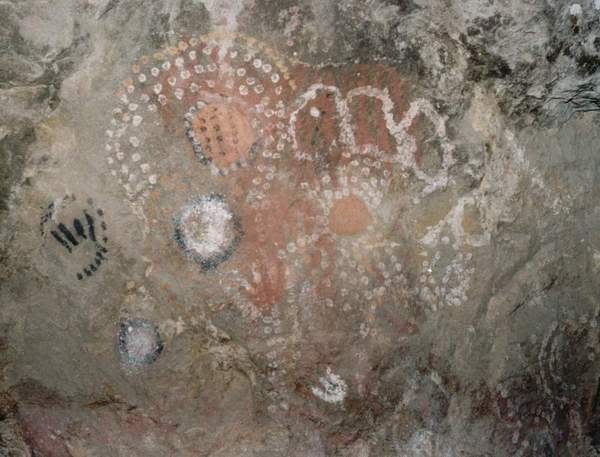
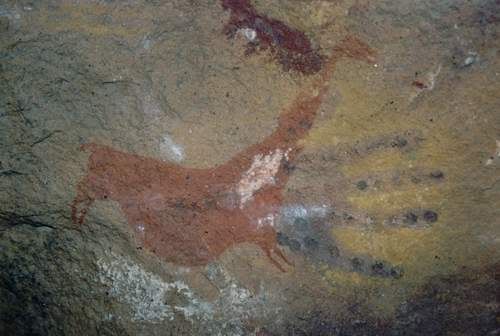
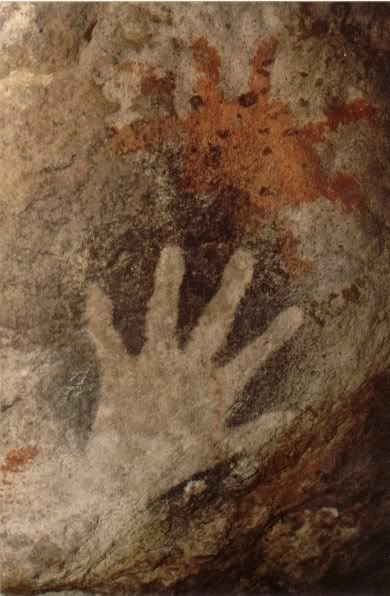
Rock art from Estancia la María is shown above.
The Cueva de las Manos in Santa Cruz, Argentina is a cave at the foot of a cliff. This site, which dates to about 8000 BCE, has negative images of hundreds of hands. Using pipes made from bone, the artists sprayed a mineral-based paint on the wall. Blocking the paint with the hand created the negative images. Most of the hands are left hands, suggesting that the artists held the spraying pipe in their right hand.
The main cave is about 79 feet deep and is 49 feet wide. The opening of the cave is 33 feet high and slopes downward to a height of about 7 feet. In addition to the stenciled images of hands, there are also depictions of humans, guanacos, rheas, felines, and hunting scenes. There are also geometric shapes and representations of the sun. There are red dots on the ceiling which were probably made by submerging hunting bolas in ink and then tossing them up. The hunting images appear to be the oldest, and those of the hands are the most recent. The ancient artists used this cave for several thousand years.
Cueva de las Manos has been listed as a World Heritage Site since 1999.
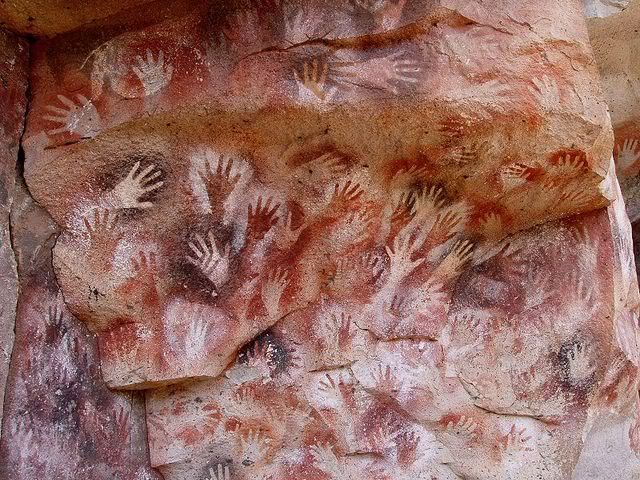
The hands painted on the wall at Cueva de las manos are shown above.
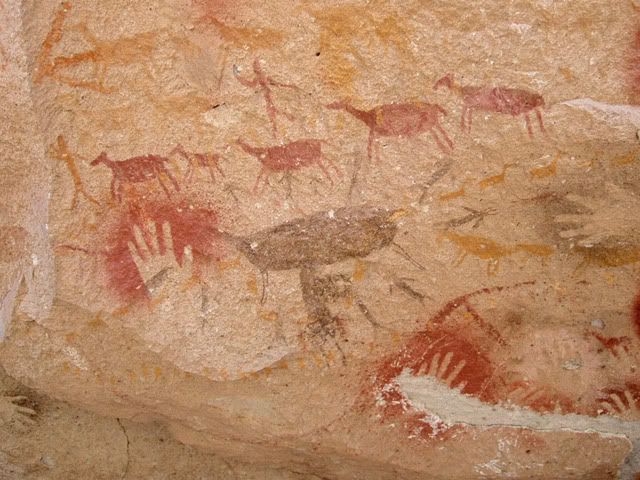
A hunting scene from Cueva de las manos is shown above.
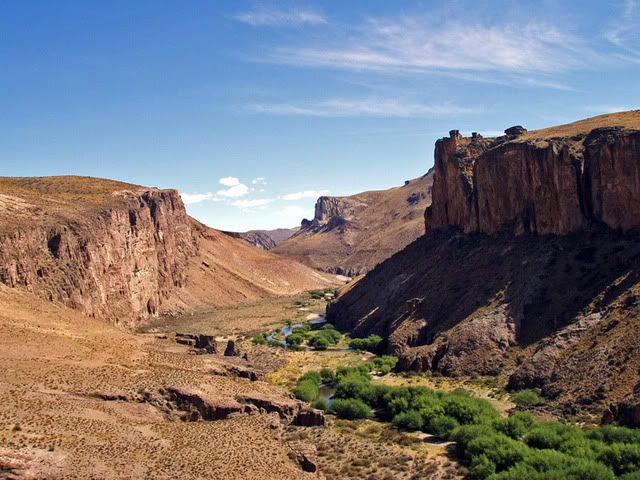
The view from Cueva de las manos is shown above.
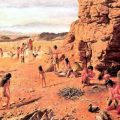



Leave a Reply